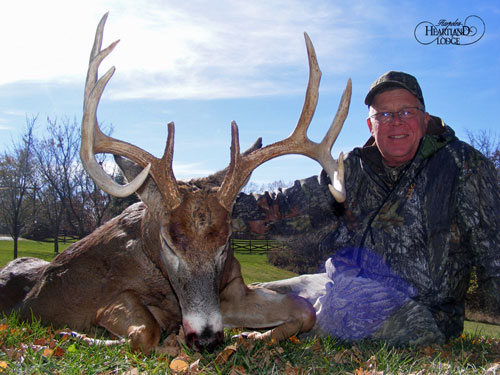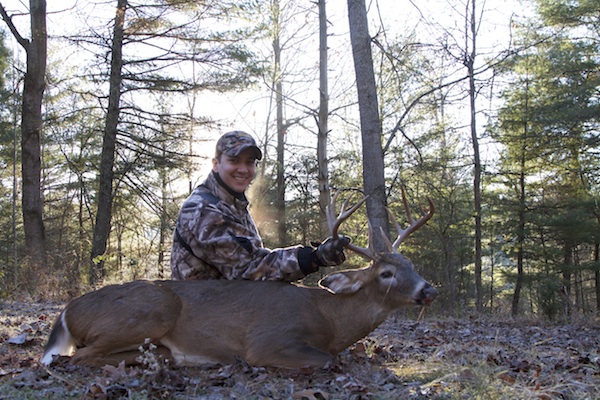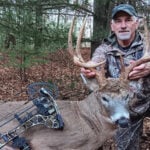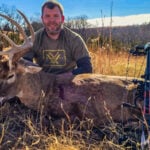LAST UPDATED: May 1st, 2015
This is the first blog in a series of Quality Deer Management (QDM) blogs that I’ll author throughout the year where I’ll share with everyone that I’m doing in my neck of the whitetail’s woods to prepare for the following season. In this “journal” you’ll find tips and information regarding hinge-cuts, building bedding areas, identifying and eradicating non-native invasive species, information on food plots, and of course tips on how to hunt the bucks that live on your property. Come along for the ride!
Hooked On It
If you’ve shared a campfire with any bowhunter across the country and asked them why they love bowhunting so much, chances are they would liken the adrenaline rush and the sport of bowhunting to a drug; something they’re addicted to, and something they need in their lives to normally function. In many senses, I have to agree. Unfortunately, though, as with any drug addiction, you develop a sense of dependency (fortunately, I’ve learned this through literature, not personal experience), and when the drug is gone, you go through withdrawals.
During the late season, a trail camera is your best friend, and most reliable scouting tool. Used correctly, they can give you the upper edge on the bucks you’ll be hunting heading into the next hunting season.
Such is the case for many bowhunters this time of year as their burning passion abruptly comes to an end when the season comes to a close. But what if I said that you could wean yourself off your bowhunting addiction heading into the offseason, while still learning about and managing your deer herd, specifically the bucks that made it through the hunting season? If that sounds exciting (and, let’s be honest, when is talking about hunting mature bucks NOT exciting?), then you’re in luck! In this blog I’ll share with you some tips and information on how to effectively and efficiently use your trail cameras to take a late season inventory of the bucks on your property.
What You’re Trying to Learn
Running trail cameras, especially this time of year, isn’t rocket science. With hunting season over or quickly nearing it’s end in most of the whitetail’s world, your trail cameras should be out monitoring your deer herd and telling you which bucks made it through the season, which ones didn’t, and which ones have moved into your property. Personally, this is one of my favorite times of the year to run trail cameras as I’m anxious to locate and identify many of the bucks that I’ve hunted and have history with over the last several months. In many cases, I’ve gotten more pictures of mature bucks during January and February than I have any other time of year! Knowing a certain buck made it through the hunting season can do wonders for your confidence heading into the offseason as your mapping out the next season’s goals.
As a deer manager, this type of “intel” can help you fine tune your game plan for the upcoming season by managing and manipulating your property’s habitat so it is best suited for the mature bucks that call it home. I recently caught up with Corey Wilkinson of Heartland Lodge, and he offered the following advice, “Taking a post season inventory can allow the manager to predict the number and quality of mature bucks for the upcoming hunting season. It can also help identify specific bucks and help with the proper aging of a buck. A buck’s age is fairly easy to identify from 1 1/2 to 3 1/2. It can prove helpful to identify these bucks at a known age when they are young, as it will prove more difficult as they mature.”
Using trail cameras to monitor your deer herd after the hunting season ends can help land managers formulate the best management plans for the following year. This mature whitetail was harvested thanks in part to the top notch management plan at Heartland Lodge in Illinois.
Where to Find the Bucks
Mother Nature hasn’t been particularly kind to us so far in 2014, especially with the brutally cold temperatures much of the country experienced in early January. However, when taking inventory, the nastier the weather the better. This time of year deer are absolute slaves to their stomach, and the worse the weather gets the easier they are to locate. Simply put, to locate mature bucks this time of year, find their preferred food source.
My brother with the 5.5-year-old 15 pointer he harvested in mid-November 2011. The buck was first photographed the previous winter, and allowed us to formulate a precise game plan for how to hunt him the following season.
In my neck of the woods, that can prove to be a difficult task. Most of my clover plots are dormant, and my fall food plot mixes of clover and oats have all but been exhausted. This means deer must find food elsewhere. In mountainous or big timbered regions, clear cuts, forest openings, or green fields with cool season grasses and forbs are a good place to start.
In the Midwest and farm country, however, look for the nearest corn or soybean that hasn’t been tilled under, and you’ll likely find every deer within a 5-mile radius. I asked Corey what his thoughts were regarding the subject and this is what he shared, “The best way to get the greatest amount of pictures during the winter months is to focus on food sources. In states where it is allowed, feeding can greatly enhance the frequency of pictures. If feeding is not allowed focus on entrance trails on a field edge that is very active. The more cameras you put out, the better the odds of capturing images of bucks and establishing a quality inventory.” It’s not complicated, folks. Find the food and you’ll find the deer.
The Chess Match Continues
While getting pictures of a mature buck this time of year is certainly cause for celebration, it’s not the end game. Remember, the goal isn’t to get trail camera pictures of a mature buck; the goal is to kill him! However, capturing trail camera images of a buck this time of year can prove to be a key piece to the puzzle.
The author with his buck, also harvested in 2011, that was frequently photographed with his brother’s buck during the winter. Capturing trail camera images of the bucks during the off season gave us a better idea of where these bucks were living and how they were using our property.
Three years ago I was running trail cameras during January and February trying to get a feel for the bucks that had survived Virginia’s liberal gun season. Throughout the early part of 2011, I captured images of what was then a 2.5 year old and 4.5 year old buck that ran together during the winter. They became mainstays on our property, and that fall, my brother and I harvested those bucks as a 5 year old and 3 year old, respectively. Those trail camera photos revealed to us our property was part of their core area, and we adjusted our hunting strategies accordingly. We shot both bucks as they left that same food plot in the morning on their way back to a bedding area.
Corey agreed with my thoughts saying, “In areas with ample food supplies a bucks core area will vary a minimal amount. If you get a picture or find the shed of a mature buck during the winter months it is very likely you will encounter him during the following hunting season in the same area. If you are running multiple cameras in a given area and capture pictures of your target buck on more than one it can help to piece together his travel patterns and narrow down bedding locations.”
Easy Does It
Just because the hunting season is over doesn’t mean you should be lazy and lackadaisical when running your trail cameras. You may have stopped trying to kill that buck until next season, but he’s just trying to make it to see the sun rise another day.
Anytime you’re checking or installing trail cameras take every precaution to be as scent free as possible. This means wearing rubber boots, rubber gloves, and spraying down with a trusted scent eliminator. I like to only check trail cameras once a week at the most, and prefer to check them on high-pressure days (human scent evaporates more quickly when there is less moisture in the air).
You want to do everything in your power to not over pressure the bucks using your property, especially this time of year. After having been hunted for 3 months straight, they’ll tolerate very little human intrusion, and if they can find suitable food sources and habitat on a neighboring property that offers better safety, they’ll relocate in no time.
Just because the season is over in your state doesn’t mean the hunt has to end. In many ways, the end of one season simply marks the beginning of the next. While the weather outside might suggest otherwise, now is a perfect time to be running your trail cameras and game planning for the next hunting season. The buck you’re after certainly isn’t going to take a day off, and neither should you!








